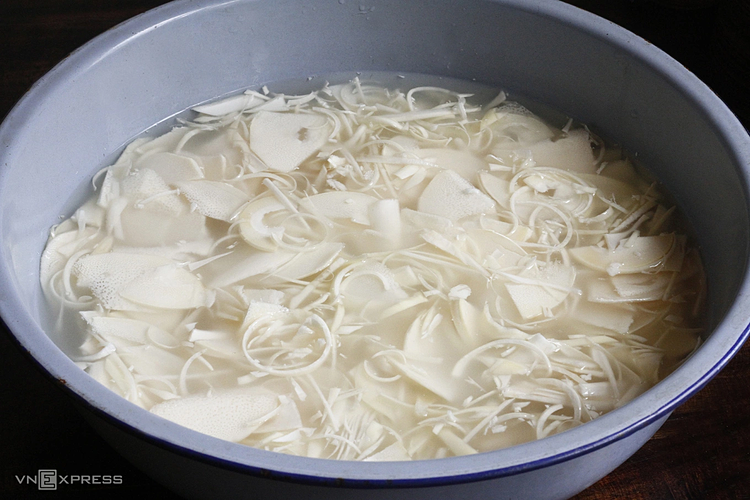In 7/2025, Ho Chi Minh City police discovered hundreds of kilograms of banana flowers soaked in water containing borax and bleaching agents at three establishments before being sold to the public. Sliced banana flowers are a common ingredient in many dishes, used as a side vegetable, contributing to the flavor and palatability of the meal. Soaking them in chemicals makes them whiter, crispier, and preserves them longer.
The harms of borax
Dr. Nguyen Duy Thinh from the Institute of Biotechnology and Food, Hanoi University of Science and Technology, explained that borax is a sodium salt of boric acid, often used in food to maintain freshness, prevent spoilage, and increase elasticity. People often add borax to banh duc (Vietnamese savory steamed rice cake) to make it firmer or to banh cuon (Vietnamese steamed rice rolls) and bun (Vietnamese rice vermicelli) to increase their chewiness.
However, borax is a toxic chemical, causing long-term health effects, especially mental decline. Therefore, Vietnam has completely banned the use of borax in food production and processing. Despite this, many businesses still secretly add borax to food as an additive to make dishes chewier and tastier.
When absorbed into the body, borax causes many negative effects, especially on the brain. It enters nerve cells, causing damage, leading to memory and intellectual development problems, especially in children. In severe cases, borax can slow down nerve development, causing mental retardation or cognitive decline. Although the harmful effects may not manifest immediately, the accumulation of borax over time will cause chronic health problems.
In addition, borax also causes digestive disorders, nutrient absorption and metabolism issues, and damage to the liver and kidneys. Even in low doses, borax can cause acute poisoning. At higher doses, it can lead to death. Acute poisoning symptoms usually appear after 6-8 hours, including nausea, diarrhea, muscle cramps, convulsions, restlessness, kidney failure, rapid heartbeat, circulatory shock, and bluish skin.
 |
Bamboo shoots are one of the foods easily adulterated with chemicals. Illustration photo: Bui Thuy |
Bamboo shoots are one of the foods easily adulterated with chemicals. Illustration photo: Bui Thuy
Dangers from food bleaching agents
Dr. Tran Hong Con, Faculty of Chemistry, Hanoi University of Science, said that using unauthorized bleaching agents or using the correct chemicals but exceeding the permitted threshold is dangerous. Currently, most bleaching agents are made from sodium sulfite (Na2SO3) and other cheap substances. Many products lack labels, packaging, expiry dates, and dosage information, posing significant health risks.
For example, the bleaching agent used for pork intestines is often hydrogen peroxide (H2O2), also known as hydrogen dioxide, which makes food whiter and eliminates odors. Theoretically, H2O2 completely decomposes after being washed off. However, when used in food, H2O2 can react with other substances in the dish, creating harmful new compounds. Therefore, the more consumers eat, the greater the risk of chemical accumulation and poisoning.
Similarly, bun (Vietnamese rice vermicelli) and pho (Vietnamese rice noodle soup) are often bleached with oxalic acid to achieve an unusually bright sheen. Tinopal, a fluorescent substance that creates a scattering effect on the product's surface, is also used. Other dishes like white bamboo shoots are also at high risk of being treated with bleaching agents to maintain their fresh color and prolong shelf life.
"Using these bleaching chemicals can lead to acute poisoning with symptoms like vomiting, dizziness, and diarrhea. In the long term, they can cause chronic diseases, including a potential risk of cancer," Dr. Con said.
Prevention
Experts recommend that the best way to prevent this is to avoid consuming food suspected of containing harmful chemicals. However, this is quite difficult because many common dishes may be adulterated with chemicals that are hard to detect. Ideally, consumers should choose food with clear origins, reputable brands, and complete labeling. Limiting the purchase of processed foods and preparing meals from fresh ingredients is the best way to ensure food safety.
Thuy Quynh












